人教版(2019)选择性必修第二册 Unit 4 Journey Across a Vast Land Reading and Thinking 课件(43张ppt内嵌视频)
文档属性
| 名称 | 人教版(2019)选择性必修第二册 Unit 4 Journey Across a Vast Land Reading and Thinking 课件(43张ppt内嵌视频) | 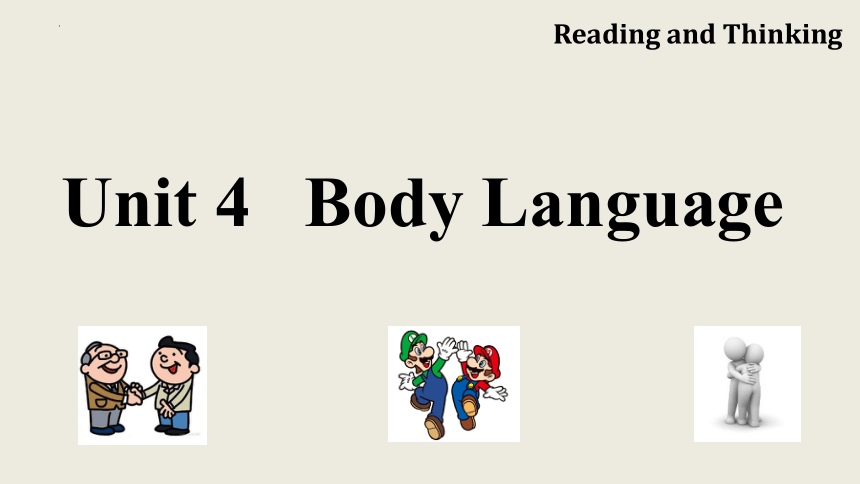 | |
| 格式 | pptx | ||
| 文件大小 | 200.8MB | ||
| 资源类型 | 教案 | ||
| 版本资源 | 人教版(2019) | ||
| 科目 | 英语 | ||
| 更新时间 | 2023-04-14 21:50:53 | ||
图片预览

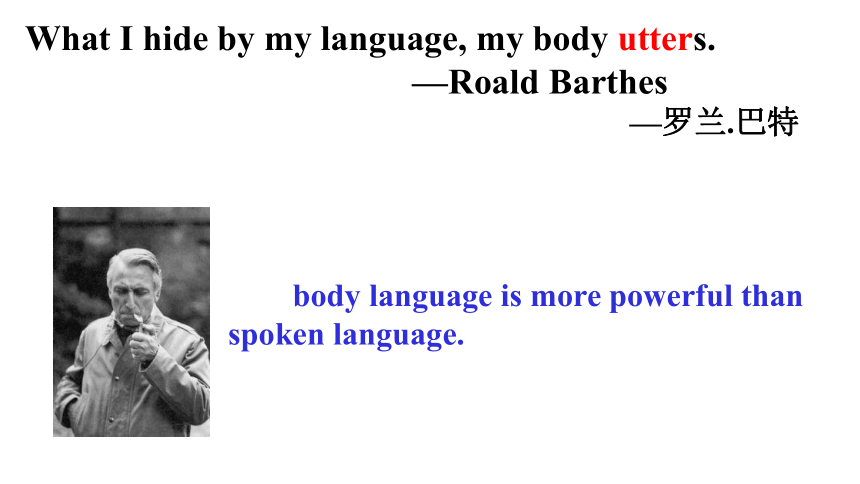
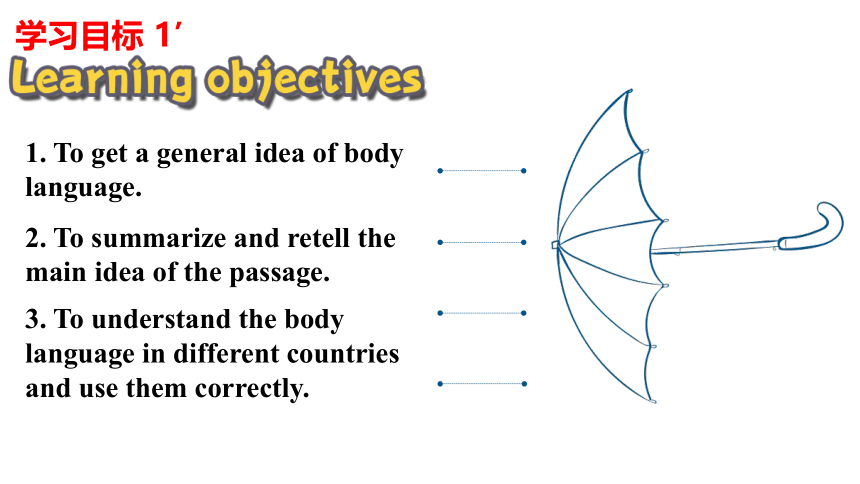
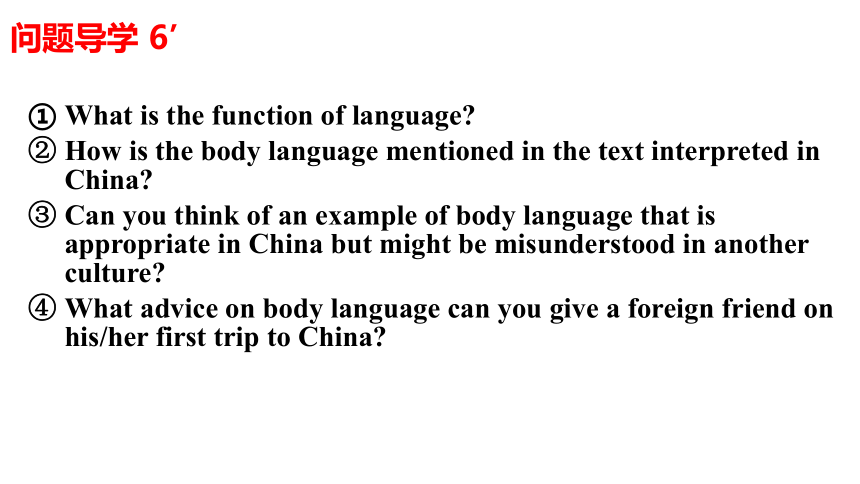
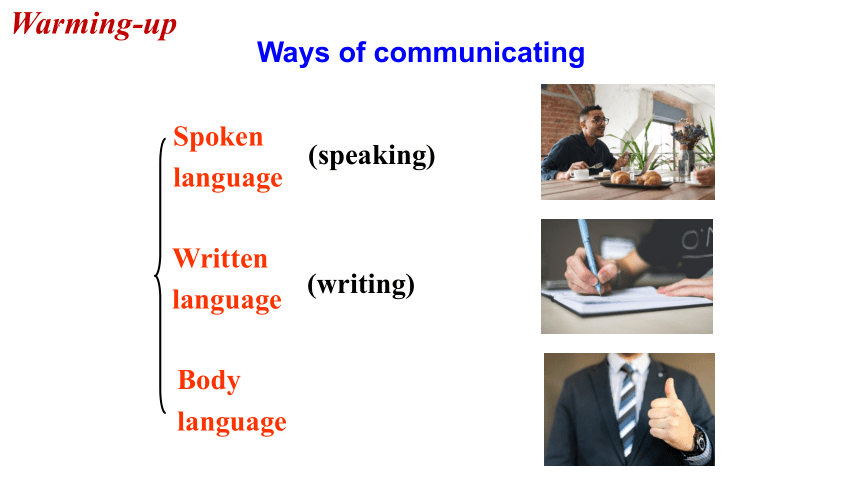
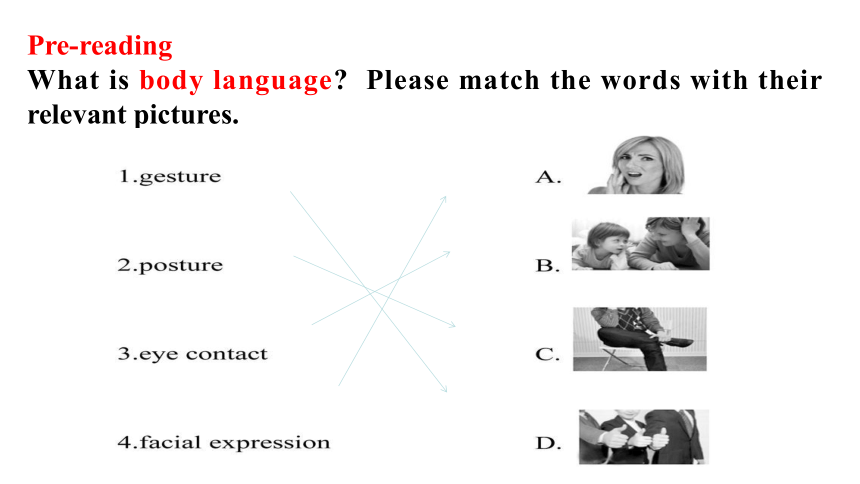
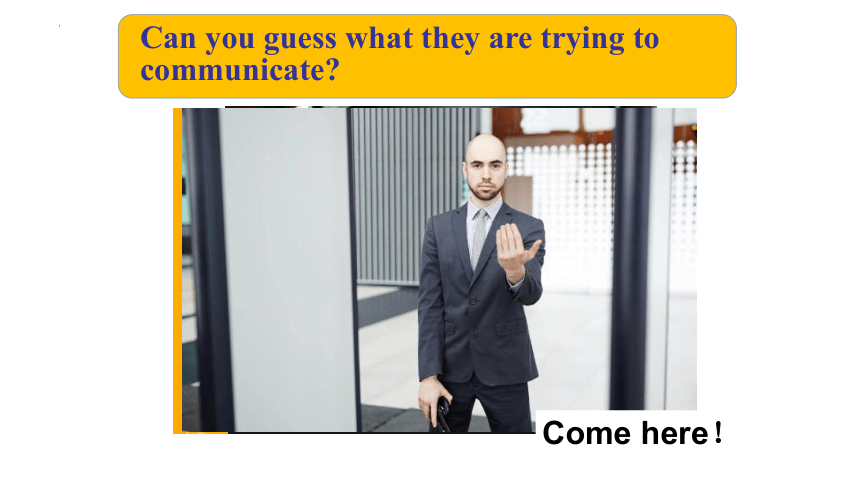
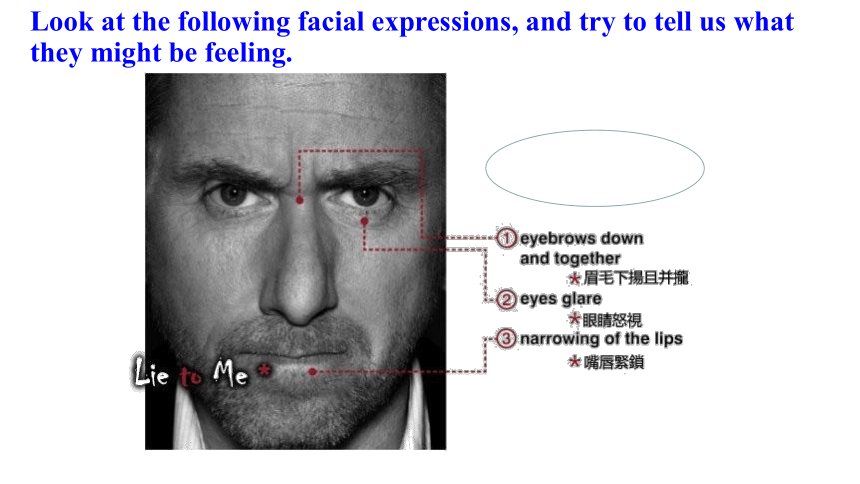
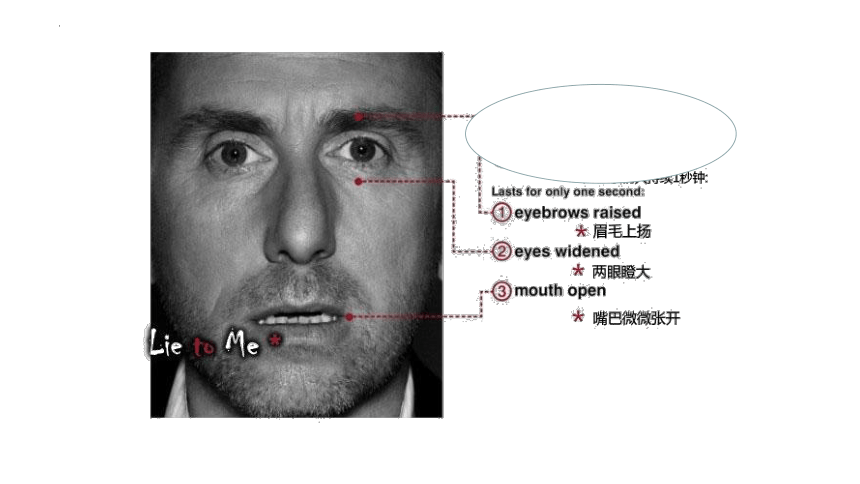
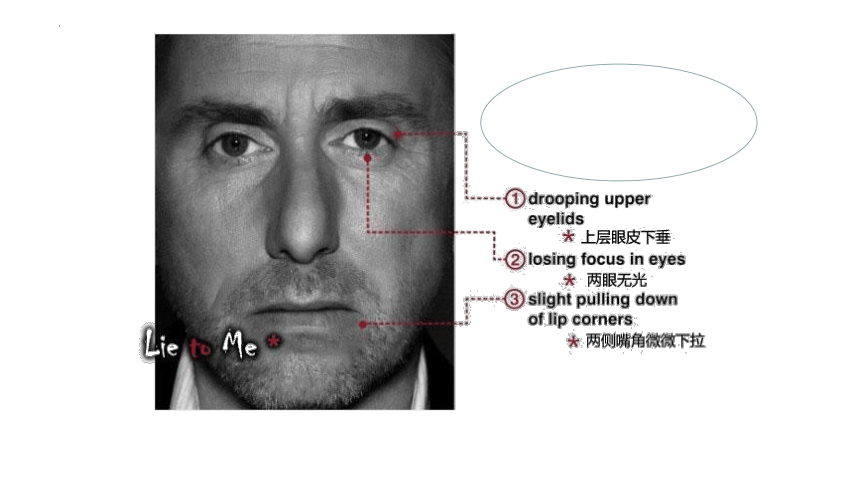
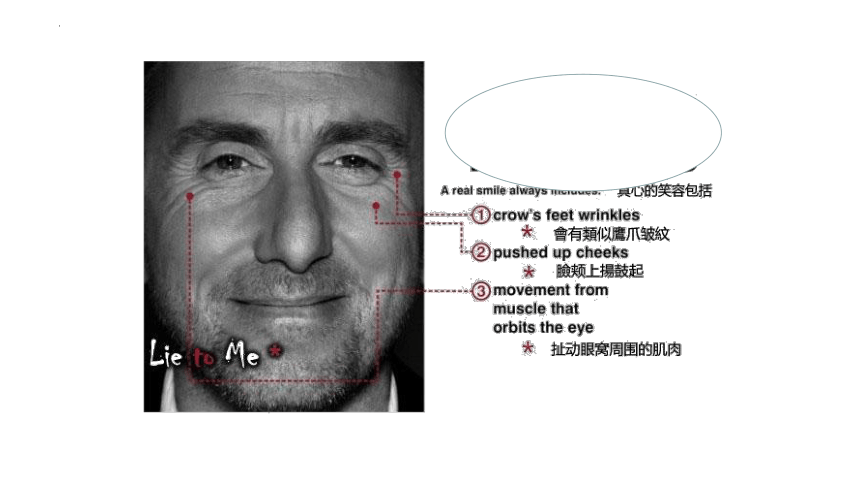
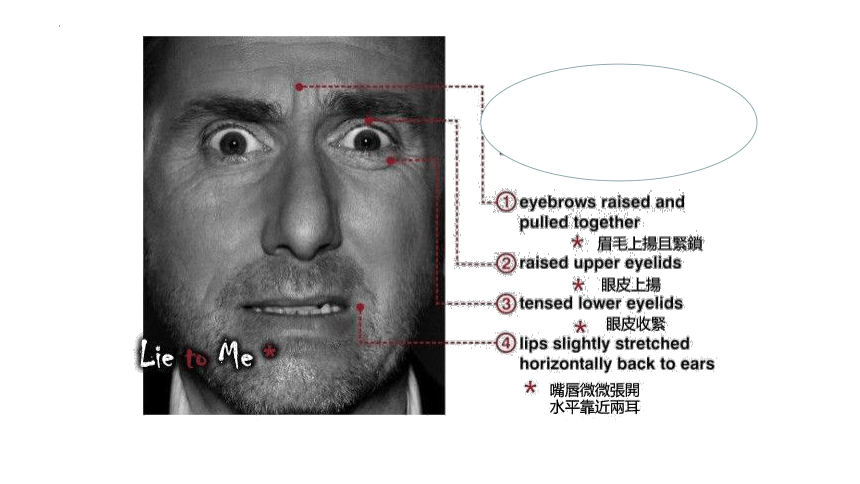
文档简介
Unit 4 Body Language
Reading and Thinking
What I hide by my language, my body utters.
—Roald Barthes
—罗兰.巴特
body language is more powerful than spoken language.
1. To get a general idea of body language.
2. To summarize and retell the main idea of the passage.
3. To understand the body language in different countries and use them correctly.
学习目标 1’
What is the function of language?
How is the body language mentioned in the text interpreted in China?
Can you think of an example of body language that is appropriate in China but might be misunderstood in another culture?
What advice on body language can you give a foreign friend on his/her first trip to China?
问题导学 6’
(speaking)
(writing)
Spoken
language
Written
language
Body
language
Ways of communicating
Warming-up
Pre-reading
What is body language? Please match the words with their relevant pictures.
sad
Can you guess what they are trying to communicate?
happy
surprise
Goodbye!
Come here!
Look at the following facial expressions, and try to tell us what they might be feeling.
Listening to how bodies talk
Listening to how bodies talk
Reading and thinking
Reading and Thinking
1. What do you think the young girl wants to convey with her body language?
I think she might want to say yes.
Personification
Understand body language
2. Look at the title of the text. What do you think will be talked about the text.
Body language.
点拨精讲 25’
(Para.1)
(Para. 2~4)
(Para. 5)
(Para. 6)
Some gestures seem to have the same meaning everywhere.
Body language plays an important role in daily communication.
Some body language has many different uses.
Match the main idea of each part.
Part 1.
Part 2.
Part 3.
Part 4.
Body language varies from culture to culture.
1.What does the word “interaction” in the first sentence in Paragraph 1 means?
A.exchange
B.relationship
C.communication
D. reaction
Scanning
2.What is the main idea of the text?
A. Body language is important in communication.
B.The differences between body language
and spoken language.
C.The characteristics of body language.
D. Body language in different cultures
3. What is the type of the passage?
A. A narration
C. An exposition
B. An argumentation
D. An application
4. How is the passage developed?
A. By giving data
C. By giving examples
B. By making comparisons
D. By giving definitions
5. When writing the text, the author is______.
A. illustating cultural differences
B. informing readers of something
C. drawing readers’ attention to some western
cultures
D. encouraging readers to do something
The crucial thing is using body language in a way that is apporopiate to the culture you are in.
6. Which statement does the author possibly agree with?
A. Never too old to learn.
B. Four eyes see more than two.
C. Action speaks louder than words.
D. When in Rome, do as the Romans do.
2. Read the text and fill in the table on
page 39.
Body language/
Gesture
Country/Region
Meaning
Eye contact
Some countries
Interest
Middle Eastern
countries
Not polite
Look down when talking to someone
Japan
Respect
Detailed reading
(Para. 2)
(Para. 3)
Body language/
Gesture
Country/Region
Meaning
Japan
Money
France
Zero
Brazil/Germany
Not polite
China
Detailed reading
Yes
(Para. 4)
Body language/
Gesture
Meaning
Many countries
Bulgaria & Southern Albania
Many countries
Bulgaria & Southern Albania
no
yes
yes
no
shake the head
nod the head
kiss on the cheek
to greet someone
France & Russia
elsewhere
Detailed reading
Country/Region
to greet someone
{5C22544A-7EE6-4342-B048-85BDC9FD1C3A}
Placing your hands together and resting them on the side of your head while closing your eyes
Moving your hand in circles over your stomach after a meal
Meaninge
attrCountry/regiontions
food/restaurants
sleep
most places
I’m full
Detailed reading
(Para5)
Body language/Gesture
Body Language/ gesture
Meaning
Country/ Region
Eye contact between men and women
Not polite
?
Middle East
?
Looking down when talking to someone
?
?
OK sign
?
?
respect
Japan
Money
Japan
Zero
France
Not polite
Brazil, Germany
Body Language/ gesture
Meaning
Country/ Region
Kissing on the cheek
Placing your hands together and resting them on the side of your head while closing your eyes
?
?
Moving your hand in circles over your stomach after a meal
?
?
Friendly
France, Russia
Sleep
Everywhere
I am full
Everywhere
(Para. 6)
1. A smile can help us __________________________ and ___________in a world of strangers and___________________
2. We can use a smile to ________________________________
_________________________________.
3. Experts suggest smiling at yourself in the mirror to__________ _______________________________________.
4. ___________________________there is nothing better than ___________________________________.
get through difficult situations
can break down barriers.
find friends
apologize ,
to greet someone,
to ask for help,
to start a conversation
make yourself feel happier and stronger
If we are feeling down or lonely,
seeing the smiling face of a good friend
Detailed reading
Structure of the exposition writing
Part 1:
Part 2:
General idea
Specific examples
Para 1 Body language expressing our thoughts and opinions
Para 2 The gesture of eye contact
Para 3 The gesture of “OK” differs in cultures
Para 4 The gesture for “yes” and “no”
Para 5 The hand gestures relating eating and sleep.
Para 6 The smiling gestures
课堂小结 1’
When we interact with other people, we use words as well as body language 1.________(express) our thoughts and opinions. Important as words are, body language can also give us 2.___________(inform) about people’s feelings. However, body language means differently in different countries. Take “making eye contact” as 3.________ example.
In some countries it is a way to display interest, 4.________ in many Middle Eastern countries, men and women are not socially 5. ________(permit) to make eye contact. The gesture for “OK” 6.________(vary) from culture to culture. In Japan, people might think it means money while in France, people may interpret it as meaning zero.
Some gestures seem to have the same 7.________(mean) everywhere. Placing your hands together and resting them on the side of your head while 8.________(close) your eyes means “sleep”.
Some body language has many different uses. A smile can help us get through difficult 9.__________(situation) and find friends in a world of strangers. We can use a smile to apologise, to greet someone, to ask for help, or to start a conversation. Experts suggest smiling at 10.________(you) in the mirror to make yourself feel happier and stronger.
to express
information
an
but
varies
meaning
closing
yourself
当堂检测 12’
permitted
situations
Thank you
Watch the video Smile Trial, and then answer the questions. (P39)
Watch the video Smile Trail
3. How is the whole passage and each paragraph is developed?
Part 1 (Para1)
Introduction to body language
Part 2 (Para2-4)
Topic sentence Supporting idea 1 (contrast)
Supporting idea 2
Part 3 (Para 5)
Part 4 (Para 6)
Topic sentence
Supporting idea 1 (identical)
Supporting idea 2
Topic sentence
Supporting idea
1-9
(identical)
总
|
分
general
↓Example
specific
2. The passage can be divided into _____ parts. Fill in each blank with a key word to complete the main idea of each part.
{5C22544A-7EE6-4342-B048-85BDC9FD1C3A}Para.
Main idea
Part 1 (Para.1)
____________ to body language: ___________ or__________of body language
Part 2
(Para. 2-4)
Body language with _________meanings in __________ cultures
Part 3
(Para. 5 )
Body language with the ________ meaning
everywhere
Part 4
(Para. 6)
Body language with ___________ uses
Introduction
importance
different
different
same
different
use...to express...; can learn a lot...by…; important; can also give us information...
three
function
4. Watch the video Smile Trial, and then discuss the questions in groups. (P39, Ex. 4)
1 Smiles can be used to hide feelings like anger, fear, or worry. Can you describe a situation where you might smile when you don't mean it?
I smile at my parents after I fail in my final exams to avoid a scolding from them or their worry about me.
Post reading
Para. 5 Some gestures seem to have the same meaning everywhere.
Para. 6 Some body language has many different uses.
1. Find and underline the topic sentence of each paragraph.
Para. 1 Words are important , but the way people stand, hold their arms, and move their hands can also give us information about their feelings.
Para. 2 Body language varies from culture to culture.
Para. 3 The gesture for “Ok” has different meanings in different cultures.
Para. 4 Even the gestures we use for “yes” and “no” differ around the world. ......There are also differences in how we touch each other, how close we stand to someone we are talking to, and how er act when we meet or part.
Skimming
____
____
but/also are signposts (标识性语言).
also a connecting sentence:呈上启下
For example, making eye contact...in some countries. In other countries....
Examples
2 Apart from fake smiles, is there any other kind of body language that can sometimes be fake?
Yes. For example, Chinese idioms “crocodile tears” and “a cat crying over a mouse’s death” mean that a person is in tears or crying with faked sadness or sympathy for another person.
3 Which is a more reliable guide for understanding someone's feelings, their body language or the words they speak?
Their body language is much more reliable than the words they say, because most people have trouble hiding their true feelings and ideas by their body language.
3. Read the text again, and then discuss these questions.
1. How is the body language mentioned in the text interpreted in China?
Some are the same in China. For example, people favour shaking hands, nodding the head or smiling when they greet someone else.
Post reading
be interpreted (as…)
被理解、领会、解读(为…)
2. Can you think of an example of body language that is appropriate in China but might be misunderstood in another culture?
Avoiding eye contact and lowering one's head may mean respect and shyness in China, whereas in some other countries they may be interpreted as rudeness.
What advice on body language can you give a foreign friend on his/her first trip to China?
Please pay attention to the social distance, which is different in China and in the West.
Prediction
Look at the title and picture on this page. What do you think the text will be talked about?
In Bulgaria and southern Albania, shaking one’s head means “no”, and nodding means “yes”. ___
Body language is used to express our thoughts
and opinions in our interactions with other people
as words. ___
Moving your hand in circles over your stomach means “I am hungry”. ___
In Japan, eye contact may demonstrate respect to look down when talking to an older person. ___
If we are feeling down or lonely, seeing the
smiling face of a good friend can make us happy.__
F
T
F
T
T
True or False
Can you guess the meaning of the word“interaction”according to the context?
What is the function of the last sentence in para 1?
Read the para 1 again and answer the question
Communication
Transitional sentence
Read the para2 to para 5 carefully and fill in the table on page 39.
Summary
Homework
review the new words and get to know the language characteristics of expository text
Body language is a powerful communication system in all cultures, but body language can signal very different things in different cultures. So, it is very important to understand and use it correctly.
Lead in
Act out the sentences on the screen without speaking. The others guess what they are communicating.
Reading and Thinking
What I hide by my language, my body utters.
—Roald Barthes
—罗兰.巴特
body language is more powerful than spoken language.
1. To get a general idea of body language.
2. To summarize and retell the main idea of the passage.
3. To understand the body language in different countries and use them correctly.
学习目标 1’
What is the function of language?
How is the body language mentioned in the text interpreted in China?
Can you think of an example of body language that is appropriate in China but might be misunderstood in another culture?
What advice on body language can you give a foreign friend on his/her first trip to China?
问题导学 6’
(speaking)
(writing)
Spoken
language
Written
language
Body
language
Ways of communicating
Warming-up
Pre-reading
What is body language? Please match the words with their relevant pictures.
sad
Can you guess what they are trying to communicate?
happy
surprise
Goodbye!
Come here!
Look at the following facial expressions, and try to tell us what they might be feeling.
Listening to how bodies talk
Listening to how bodies talk
Reading and thinking
Reading and Thinking
1. What do you think the young girl wants to convey with her body language?
I think she might want to say yes.
Personification
Understand body language
2. Look at the title of the text. What do you think will be talked about the text.
Body language.
点拨精讲 25’
(Para.1)
(Para. 2~4)
(Para. 5)
(Para. 6)
Some gestures seem to have the same meaning everywhere.
Body language plays an important role in daily communication.
Some body language has many different uses.
Match the main idea of each part.
Part 1.
Part 2.
Part 3.
Part 4.
Body language varies from culture to culture.
1.What does the word “interaction” in the first sentence in Paragraph 1 means?
A.exchange
B.relationship
C.communication
D. reaction
Scanning
2.What is the main idea of the text?
A. Body language is important in communication.
B.The differences between body language
and spoken language.
C.The characteristics of body language.
D. Body language in different cultures
3. What is the type of the passage?
A. A narration
C. An exposition
B. An argumentation
D. An application
4. How is the passage developed?
A. By giving data
C. By giving examples
B. By making comparisons
D. By giving definitions
5. When writing the text, the author is______.
A. illustating cultural differences
B. informing readers of something
C. drawing readers’ attention to some western
cultures
D. encouraging readers to do something
The crucial thing is using body language in a way that is apporopiate to the culture you are in.
6. Which statement does the author possibly agree with?
A. Never too old to learn.
B. Four eyes see more than two.
C. Action speaks louder than words.
D. When in Rome, do as the Romans do.
2. Read the text and fill in the table on
page 39.
Body language/
Gesture
Country/Region
Meaning
Eye contact
Some countries
Interest
Middle Eastern
countries
Not polite
Look down when talking to someone
Japan
Respect
Detailed reading
(Para. 2)
(Para. 3)
Body language/
Gesture
Country/Region
Meaning
Japan
Money
France
Zero
Brazil/Germany
Not polite
China
Detailed reading
Yes
(Para. 4)
Body language/
Gesture
Meaning
Many countries
Bulgaria & Southern Albania
Many countries
Bulgaria & Southern Albania
no
yes
yes
no
shake the head
nod the head
kiss on the cheek
to greet someone
France & Russia
elsewhere
Detailed reading
Country/Region
to greet someone
{5C22544A-7EE6-4342-B048-85BDC9FD1C3A}
Placing your hands together and resting them on the side of your head while closing your eyes
Moving your hand in circles over your stomach after a meal
Meaninge
attrCountry/regiontions
food/restaurants
sleep
most places
I’m full
Detailed reading
(Para5)
Body language/Gesture
Body Language/ gesture
Meaning
Country/ Region
Eye contact between men and women
Not polite
?
Middle East
?
Looking down when talking to someone
?
?
OK sign
?
?
respect
Japan
Money
Japan
Zero
France
Not polite
Brazil, Germany
Body Language/ gesture
Meaning
Country/ Region
Kissing on the cheek
Placing your hands together and resting them on the side of your head while closing your eyes
?
?
Moving your hand in circles over your stomach after a meal
?
?
Friendly
France, Russia
Sleep
Everywhere
I am full
Everywhere
(Para. 6)
1. A smile can help us __________________________ and ___________in a world of strangers and___________________
2. We can use a smile to ________________________________
_________________________________.
3. Experts suggest smiling at yourself in the mirror to__________ _______________________________________.
4. ___________________________there is nothing better than ___________________________________.
get through difficult situations
can break down barriers.
find friends
apologize ,
to greet someone,
to ask for help,
to start a conversation
make yourself feel happier and stronger
If we are feeling down or lonely,
seeing the smiling face of a good friend
Detailed reading
Structure of the exposition writing
Part 1:
Part 2:
General idea
Specific examples
Para 1 Body language expressing our thoughts and opinions
Para 2 The gesture of eye contact
Para 3 The gesture of “OK” differs in cultures
Para 4 The gesture for “yes” and “no”
Para 5 The hand gestures relating eating and sleep.
Para 6 The smiling gestures
课堂小结 1’
When we interact with other people, we use words as well as body language 1.________(express) our thoughts and opinions. Important as words are, body language can also give us 2.___________(inform) about people’s feelings. However, body language means differently in different countries. Take “making eye contact” as 3.________ example.
In some countries it is a way to display interest, 4.________ in many Middle Eastern countries, men and women are not socially 5. ________(permit) to make eye contact. The gesture for “OK” 6.________(vary) from culture to culture. In Japan, people might think it means money while in France, people may interpret it as meaning zero.
Some gestures seem to have the same 7.________(mean) everywhere. Placing your hands together and resting them on the side of your head while 8.________(close) your eyes means “sleep”.
Some body language has many different uses. A smile can help us get through difficult 9.__________(situation) and find friends in a world of strangers. We can use a smile to apologise, to greet someone, to ask for help, or to start a conversation. Experts suggest smiling at 10.________(you) in the mirror to make yourself feel happier and stronger.
to express
information
an
but
varies
meaning
closing
yourself
当堂检测 12’
permitted
situations
Thank you
Watch the video Smile Trial, and then answer the questions. (P39)
Watch the video Smile Trail
3. How is the whole passage and each paragraph is developed?
Part 1 (Para1)
Introduction to body language
Part 2 (Para2-4)
Topic sentence Supporting idea 1 (contrast)
Supporting idea 2
Part 3 (Para 5)
Part 4 (Para 6)
Topic sentence
Supporting idea 1 (identical)
Supporting idea 2
Topic sentence
Supporting idea
1-9
(identical)
总
|
分
general
↓Example
specific
2. The passage can be divided into _____ parts. Fill in each blank with a key word to complete the main idea of each part.
{5C22544A-7EE6-4342-B048-85BDC9FD1C3A}Para.
Main idea
Part 1 (Para.1)
____________ to body language: ___________ or__________of body language
Part 2
(Para. 2-4)
Body language with _________meanings in __________ cultures
Part 3
(Para. 5 )
Body language with the ________ meaning
everywhere
Part 4
(Para. 6)
Body language with ___________ uses
Introduction
importance
different
different
same
different
use...to express...; can learn a lot...by…; important; can also give us information...
three
function
4. Watch the video Smile Trial, and then discuss the questions in groups. (P39, Ex. 4)
1 Smiles can be used to hide feelings like anger, fear, or worry. Can you describe a situation where you might smile when you don't mean it?
I smile at my parents after I fail in my final exams to avoid a scolding from them or their worry about me.
Post reading
Para. 5 Some gestures seem to have the same meaning everywhere.
Para. 6 Some body language has many different uses.
1. Find and underline the topic sentence of each paragraph.
Para. 1 Words are important , but the way people stand, hold their arms, and move their hands can also give us information about their feelings.
Para. 2 Body language varies from culture to culture.
Para. 3 The gesture for “Ok” has different meanings in different cultures.
Para. 4 Even the gestures we use for “yes” and “no” differ around the world. ......There are also differences in how we touch each other, how close we stand to someone we are talking to, and how er act when we meet or part.
Skimming
____
____
but/also are signposts (标识性语言).
also a connecting sentence:呈上启下
For example, making eye contact...in some countries. In other countries....
Examples
2 Apart from fake smiles, is there any other kind of body language that can sometimes be fake?
Yes. For example, Chinese idioms “crocodile tears” and “a cat crying over a mouse’s death” mean that a person is in tears or crying with faked sadness or sympathy for another person.
3 Which is a more reliable guide for understanding someone's feelings, their body language or the words they speak?
Their body language is much more reliable than the words they say, because most people have trouble hiding their true feelings and ideas by their body language.
3. Read the text again, and then discuss these questions.
1. How is the body language mentioned in the text interpreted in China?
Some are the same in China. For example, people favour shaking hands, nodding the head or smiling when they greet someone else.
Post reading
be interpreted (as…)
被理解、领会、解读(为…)
2. Can you think of an example of body language that is appropriate in China but might be misunderstood in another culture?
Avoiding eye contact and lowering one's head may mean respect and shyness in China, whereas in some other countries they may be interpreted as rudeness.
What advice on body language can you give a foreign friend on his/her first trip to China?
Please pay attention to the social distance, which is different in China and in the West.
Prediction
Look at the title and picture on this page. What do you think the text will be talked about?
In Bulgaria and southern Albania, shaking one’s head means “no”, and nodding means “yes”. ___
Body language is used to express our thoughts
and opinions in our interactions with other people
as words. ___
Moving your hand in circles over your stomach means “I am hungry”. ___
In Japan, eye contact may demonstrate respect to look down when talking to an older person. ___
If we are feeling down or lonely, seeing the
smiling face of a good friend can make us happy.__
F
T
F
T
T
True or False
Can you guess the meaning of the word“interaction”according to the context?
What is the function of the last sentence in para 1?
Read the para 1 again and answer the question
Communication
Transitional sentence
Read the para2 to para 5 carefully and fill in the table on page 39.
Summary
Homework
review the new words and get to know the language characteristics of expository text
Body language is a powerful communication system in all cultures, but body language can signal very different things in different cultures. So, it is very important to understand and use it correctly.
Lead in
Act out the sentences on the screen without speaking. The others guess what they are communicating.
